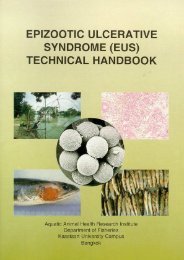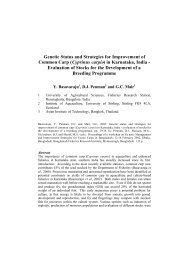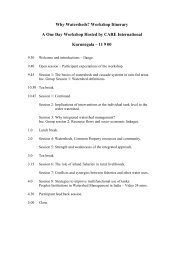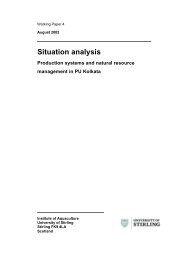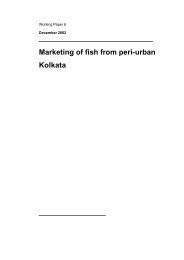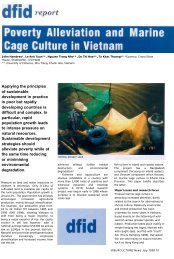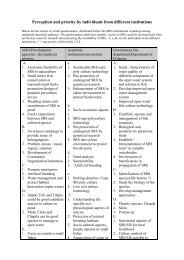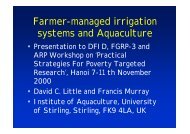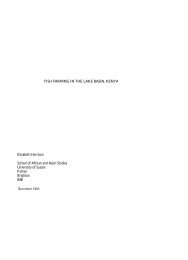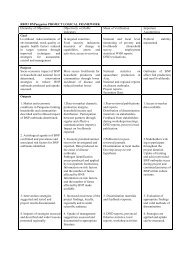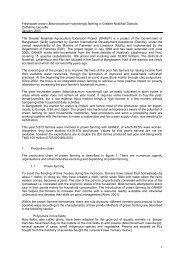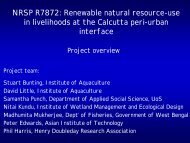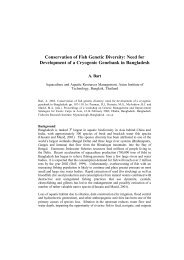An epidemiological approach to aquatic disease control - DFID@Stir
An epidemiological approach to aquatic disease control - DFID@Stir
An epidemiological approach to aquatic disease control - DFID@Stir
Create successful ePaper yourself
Turn your PDF publications into a flip-book with our unique Google optimized e-Paper software.
FINAL TECHNICAL REPORTSubmitted <strong>to</strong> DFIDProject R No 7051<strong>An</strong> <strong>epidemiological</strong> <strong>approach</strong> <strong>to</strong> <strong>aquatic</strong> <strong>disease</strong> <strong>control</strong>: a study of the riskfac<strong>to</strong>rs associated with outbreaks of White Spot Diseasein artisanal systems in Vietnam and India.KL Morgan, JF Turnbull, NV Hao, CV Mohan and F CorsinUniversity of Liverpool, University of Stirling, Research Centre for Aquaculture Number 2 andBangalore Agricultural University
CONTENTSSectionPage numberEXECUTIVE SUMMARY....................................................................... 3BACKGROUND ...................................................................................... 5PROJECT PURPOSE .............................................................................. 8OUTPUTS................................................................................................. 9ACTIVITIES.......................................................................................... 15CONTRIBUTION OF OUTPUTS TO DEVELOPMENTAL IMPACT 20Appendix I – REFERENCESAppendix II - THE SCIENTIFIC COLLABORATORSAppendix III - LOGISTIC FRAMEWORK FROM PROJECT MEMORANDUMAppendix IV - DRAFT MANUSCRIPTSAppendix V - SPECIMENS OF FARMERS REPORTS AND INFORMATION2
EXECUTIVE SUMMARYTHE PROJECTThis project adapted existing <strong>epidemiological</strong> techniques <strong>to</strong> the study of risk fac<strong>to</strong>rs for White SpotDisease (WSD) shrimp in two vulnerable farming systems in the Mekong delta of Vietnam andSouth West India. It is one of the first major projects <strong>to</strong> apply existing <strong>epidemiological</strong> techniques<strong>to</strong> the study and <strong>control</strong> of <strong>aquatic</strong> <strong>disease</strong>. The focus on two different artisanal systems maximisedthe scientific and socio-economic benefits of the project and allowed the results of the research <strong>to</strong>be applied <strong>to</strong> a wider range of culture systems.PROJECT PURPOSE – from project Log FrameThe project purpose was <strong>to</strong> improve techniques for study and <strong>control</strong> of <strong>aquatic</strong> <strong>disease</strong> in the Asiathrough the development of knowledge, skills and pro<strong>to</strong>cols in <strong>aquatic</strong> epidemiology, focusing onshrimp WSD. The objectively Verifiable Indica<strong>to</strong>rs (OVIs) have been met in full. Details of theroutes of dissemination, other projects that have adopted methodologies used and developed in thisstudy and details of all publications are contained in OUTPUTS and Appendix IV.OUTPUTSAll the OVIs have been produced. Risk fac<strong>to</strong>rs have been identified and reported <strong>to</strong> localstakeholders. They have also been disseminated by a variety of other routes. As planned potentialinterventions have been identified and field trials funded by the Vietnamese Government have beenundertaken. Further funding has also been sought from DFID and an application submitted <strong>to</strong> theWellcome Foundation. Epidemiological techniques have been used by all the participants outwiththis project and by colleagues of the participants. Teaching material has been produced and used inVietnam, India, UK, Australia and Mexico.The volume and quantity of data produced has exceeded expectations. As a result the potential fordata analyses is also greater than expected. All the analyses planed in the original proposal havebeen completed but some advanced cluster and survival analyses with time dependent variables isstill ongoing. Scientific understanding of WSD and methodologies for studying <strong>aquatic</strong> <strong>disease</strong> ingeneral have been improved and there is evidence of both dissemination and uptake. Allagreements with farmers were fulfilled and the information on the farming system and WSD werereported back <strong>to</strong> them using a variety of techniques, within one year of the start of data collection ineach country. Comments from farmers and responses <strong>to</strong> project evaluation forms suggested thatthey found the detailed description of their system very useful. It allowed them <strong>to</strong> compare theiractivities with those of farmers performing better and worse than themselves.3
IMPACT ON DEVELOPMENT OBJECTIVESRisk fac<strong>to</strong>rs were identified and decision-making <strong>to</strong>ols supplied <strong>to</strong> vulnerable farmers. Although noformal intervention study has been initiated, anecdotal evidence from both study sites suggests thatfarmers have changed farming practices in response <strong>to</strong> the findings of this project. There is an everincreasing need for the dissemination of existing results and development of further strategies <strong>to</strong><strong>control</strong> <strong>aquatic</strong> <strong>disease</strong>. At the start of the project it was estimated that 10,000 families relied onrice-shrimp farming in the Mekong delta. A recent communication from Can Tho University hassuggested that there has been a dramatic increase in the number of rice-shrimp farmers as a result ofthe perceived success of existing farmers. However, in the last year it is estimated that more than110,000ha of shrimp culture failed due <strong>to</strong> high mortalities. Given an average pond size of 0.33ha,this represents one third of a million families affected by severe losses.THE FUTUREAll obligations have been fulfilled. A concept note for a second phase has been submitted and a fullproject memorandum is in preparation. This will build on the scientific results of this project butalso investigate more generic issues regarding uptake of information and generating influence and avariety of levels from the farm <strong>to</strong> government.4
BACKGROUNDThis ReportThis report is a summary of the activities and outputs associated with project R7051. Furtherdetails of the activities are contained within annual and quarterly reports submitted <strong>to</strong> DFID. Theoutputs are described in detail and where appropriate material is appended <strong>to</strong> this report.Manuscripts still in preparation will be publicised through DFID web sites.The projectThis project adapted existing <strong>epidemiological</strong> techniques <strong>to</strong> the study of risk fac<strong>to</strong>rs for White SpotDisease (WSD) of shrimp in two vulnerable farming systems in the Mekong delta of Vietnam andSouth West India. It is one of the first major projects <strong>to</strong> apply and adapt existing <strong>epidemiological</strong>techniques <strong>to</strong> the study and <strong>control</strong> of <strong>aquatic</strong> <strong>disease</strong>. The focus on two different artisanal systemsmaximised the scientific and socio-economic benefits of the project and allowed the results of theresearch <strong>to</strong> be applied <strong>to</strong> a wider range of culture systems.White Spot DiseaseWSD is a pandemic <strong>disease</strong> of shrimp caused by an unclassified virus commonly known as WhiteSpot Syndrome Virus (WSSV). WSD outbreaks were first detected in in Penaeus japonicus andP.chinensis in Japan and China in 1993 (Nakano et al, 1994; Zhan et al., 1998) and in the following18 months the outbreak spread <strong>to</strong> the majority of the shrimp farming countries in Asia. Othershrimp species were infected including P.monodon which is by far the most economically importantspecies of the continent (<strong>An</strong>onymous 1997; Mohan et al., 1998; Park et al, 1998; Wongteerasupayaet al, 1995; Lo et al, 1998; Hao et al., 1997). WSSV has now also been reported in shrimp farms inCentral and South America (Calderon, 2000).The impact of WSDThe massive social and economic impact of WSD has been widely reported and discussed.Estimates suggest that losses due <strong>to</strong> WSD exceeded 0.5 billion US$ in Thailand during 1996 andover 2 billion in SE Asia in 1997 (Flegel and Alday Sanz, 1998). Reports have suggested that WSDhas severely damaged small-scale coastal aquaculture systems throughout Asia. The effects haveranged from lost crops <strong>to</strong> abandonment of whole production areas. It is, however, difficult <strong>to</strong>accurately quantify the economic and social effect of this <strong>disease</strong>. WSD and the response of thosedepending on shrimp farming for their livelihoods are in a constant state of co-evolution. In such arelationship it is difficult <strong>to</strong> separate the effect of the <strong>disease</strong> from people’s response <strong>to</strong> the <strong>disease</strong>.Methods were developed <strong>to</strong> calculate the effect of WSD during this project and information from5
However, despite of the adoption of strategies <strong>to</strong> reduce or eliminate WSSV from the system andthe use of immunostimulants (Song et al., 1997; Chang et al., 1999) only limited <strong>control</strong> of WSDhad been achieved.Aquatic EpidemiologyDuring the latter half of the 1990s the scientific community identified the need for a more holistic,population-based <strong>approach</strong> <strong>to</strong> the understanding and <strong>control</strong> <strong>aquatic</strong> <strong>disease</strong> including WSD.Epidemiology was considered <strong>to</strong> be essential <strong>to</strong> practical <strong>aquatic</strong> health <strong>control</strong> by manyorganisations and individuals (FAO, DFID, ACIAR, NACA and others). Epidemiology combinesthe study of <strong>disease</strong> in populations and an inherent consideration of complex causes with effectiveparticipa<strong>to</strong>ry methods.At the time this project was initiated there had been very few population based studies studying<strong>aquatic</strong> animal <strong>disease</strong>s and their impact on people. There are still very few examples of researchinvestigating the risk fac<strong>to</strong>rs for WSD in real populations (Hettiarachchi et al., 1999;Withyachumnarnkul, 1999). With the exception of a brief description of a WSD outbreak in Japan(Nakano et al., 1994) this project has generated the first <strong>epidemiological</strong> study of WSD (seeOUTPUTS).ParticipationAs previously stated applied epidemiology requires a practical participa<strong>to</strong>ry component. Althoughthe nature of such participation may be unfamiliar <strong>to</strong> social scientists it has a long his<strong>to</strong>ry ofeffectively dealing with problems. Participation by farmers and local institutions was essential <strong>to</strong>the success of this project. The initial research plan was arrived at through expert consultation,however, implementation of the plan required extensive consultation. Stakeholders were introduced<strong>to</strong> the team, informed of the aims, the aims were discussed and appropriate changes made <strong>to</strong> theresearch plan. <strong>An</strong> essential part of this process was an agreement entered in<strong>to</strong> with the farmers. Theresearchers promised <strong>to</strong> deliver findings back <strong>to</strong> farmers within one year. This promise wasfulfilled in both phases of the project and produced a great deal of positive feedback fromparticipating farmers.Value for moneyThe project has been extremely successful achieving all the initial objectives and far exceedingexpectations in terms of data collected and advances in understanding. The success of the projectwas in large part due <strong>to</strong> the effort of the collabora<strong>to</strong>rs at all levels; farmers, research assistants and7
senior scientific collabora<strong>to</strong>rs. The research was extremely cost effective with most of the fundsbeing spent in developing countries. Farmers were compensated for all samples taken from theirfarms while the scientific collabora<strong>to</strong>rs did not charge for any of their time. Neither Prof. Morgannor Dr Turnbull costed in any of their time and while Dr Mohan and Dr Hao were allocated funds inthe proposal, they chose <strong>to</strong> reallocate those funds <strong>to</strong> support the research.The futureWhile all obligations regarding dissemination of information have been fulfilled, this project did notintended <strong>to</strong> implement full intervention studies. A concept note for a second phase has beensubmitted and a full project memorandum is in preparation. This will build on the scientific resultsof this project but also investigate more generic issues regarding uptake of information andgenerating influence and a variety of levels from the farm <strong>to</strong> government.PROJECT PURPOSEFrom the Project Memorandum Logical Framework (Appendix III)The project purpose was <strong>to</strong> improve techniques for study and <strong>control</strong> of <strong>aquatic</strong> <strong>disease</strong> in the Asiathrough the development of knowledge, skills and pro<strong>to</strong>cols in <strong>aquatic</strong> epidemiology, focusing onshrimp White Spot Disease (WSD) in artisanal systems in India and Vietnam.Objectively Verifiable Indica<strong>to</strong>rsBy the end of the project: <strong>epidemiological</strong> methodologies for the study and <strong>control</strong> of <strong>aquatic</strong><strong>disease</strong> developed, information and techniques extended <strong>to</strong> participants and others.These have been met in full. Details of the routes of dissemination, other projects that have adoptedmethodologies used or developed in this study and all publications are contained in OUTPUTS.Methodologies and techniquesThe two studies in Vietnam and India, allowed the development of practical <strong>epidemiological</strong>techniques for use in <strong>aquatic</strong> systems. Two different <strong>approach</strong>es were adopted, in Vietnam a smallnumber of farms were involved with the focus on detailed examination pond level risk fac<strong>to</strong>rs foroutbreaks of <strong>disease</strong>. In India the study focused on routes of transmission of WSSV, involving alarger number of farmers and potential sources of the virus from outside the farm. The activitiesundertaken and the techniques developed during this project have contributed significantly <strong>to</strong> thedevelopment of <strong>aquatic</strong> epidemiology.8
InformationInformation produced during the study has already provided farmers with decision-making <strong>to</strong>ols.For example a robust and simple technique was developed in Vietnam <strong>to</strong> allow farmers <strong>to</strong> decidewhen emergency harvest was necessary. This was based on the number of dead shrimp observed atthe edge of the pond. Details of the farming systems and the risk fac<strong>to</strong>rs for WSD in both countrieswas also presented <strong>to</strong> and discussed with the farmers. The farmers considered such informationvaluable and preliminary evidence suggests that it improved their understanding of the <strong>disease</strong>problem.Information produced has also significantly improved understanding of WSD in specific and thestudy of <strong>aquatic</strong> <strong>disease</strong>s in general.InterventionsWith the results from this project we are in the process of applying for further funding <strong>to</strong> developand test potential interventions <strong>to</strong> reduce the impact of WSD. This would be linked <strong>to</strong> a genericstudy of potential routes of dissemination and uptake of research findings.OUTPUTSFrom Project Memorandum Logistic Framework (Appendix III)1. Risk fac<strong>to</strong>rs for WSD outbreaks identified.2. Rational intervention strategies designed.3. Project findings developed and disseminated, understanding and capacity in <strong>aquatic</strong>epidemiology in key regional organisations promoted.Objectively Verifiable Indica<strong>to</strong>rs1. By the end of the project: risk fac<strong>to</strong>rs for <strong>disease</strong> identified and <strong>epidemiological</strong> methods andresults published.2. The initiation of preliminary field trials in Vietnam and production of subsequent grant proposalsfor <strong>control</strong>led application of further intervention strategies.3.- Participants use of <strong>epidemiological</strong> skills demonstrated, strategies being applied for this andother <strong>disease</strong>s, teaching material produced.The assumptions concerning the presence of the <strong>disease</strong> and the compliance of the participants wereall met. All the OVIs have been produced. Risk fac<strong>to</strong>rs have been identified and reported <strong>to</strong> localstakeholders. They have also been disseminated by a variety of other routes (see below). Asplanned, potential interventions have been identified and field trials funded by the VietnameseGovernment have been undertaken. Further funding has also been sought from DFID and an9
application submitted <strong>to</strong> the Wellcome Foundation. Epidemiological techniques have been used byall the participants outwith this project and by colleagues of the participants (see below). Teachingmaterial has been produced and used in Vietnam, India, UK, Australia and Mexico.Details of outputsParticipating FarmersThe 24 and 70 farmers in Vietnam and India participated in a successful project. It was anticipatedthat farmers might be reluctant <strong>to</strong> participate in an observational study, where no advice is providedduring the data collection phase, particularly in the face of a devastating <strong>disease</strong> epidemic.However, by combining a spectrum of participa<strong>to</strong>ry <strong>approach</strong>es, compliance was maintainedthroughout the project. This was reflected by the excellent farmer attendance at the end of projectmeetings and the enthusiastic response <strong>to</strong> the presentations. In both Vietnam and India the meetings<strong>to</strong> present the project findings were attended by representatives from all the participating farms andsignificant numbers of other stakeholders including farmers and others. In India where 70 farmerswere enrolled the final meeting was attended by over 250 people. At these meetings, descriptionsof the local farming systems, risk fac<strong>to</strong>rs and potential interventions were described both verballyand in written form <strong>to</strong> the farmers and extension workers with suggestions for implementation. InVietnam all the information was presented in Vietnamese, whereas in India it was presented both inthe local language of Kannada and English. From the questions and discussions at these meetings itwould appear that the farmers not only unders<strong>to</strong>od the presented information but were able <strong>to</strong>appreciate its implications for <strong>disease</strong> <strong>control</strong>. After the group meetings all the farmers involved inthe study were met individually, <strong>to</strong> provide them with a report in their own language describing thefindings of the project in relation <strong>to</strong> their farm. According <strong>to</strong> Vietnamese authorities, the rate offailure of farms in the study site decreased from 90% in 1998 <strong>to</strong> 20% in 2000. However, it iscurrently extremely difficult <strong>to</strong> accurately evaluate the impact of a particular projectrecommendation. DFID has commissioned a study <strong>to</strong> examine the uptake of outputs from thisproject in Vietnam.Participating ScientistsAll scientists involved in the project were part of a successful collaboration, the success of whichwas due <strong>to</strong> the knowledge, enthusiasm and effort of the research team. In particular Flavio Corsin,the research scientist primarily responsible for data collection and analysis under<strong>to</strong>ok an exceptionalworkload. Organisational challenges were resolved, farmers were recruited, their compliancemaintained and a complete data set collected. Excellent empathy and understanding was generated10
Netherlands. Pradhan is now undertaking a PhD project in the Department of Aquaculture,Mangalore Fisheries College. Guruchannabasavanna is currently attending a MSc course in theDepartment of Aquaculture, Mangalore Fisheries College and is using samples from the DFIDproject for his dissertation. Finally Arun Padiyar, who is still employed at the Manglaore FisheriesCollege analysing samples and data from the DFID project, also received training in his<strong>to</strong>logy,water quality analyses, data collection and entry.Three people involved in the project were trained in his<strong>to</strong>pathology processing and basicinterpretation. These included Jagannathand and Sasikala who both subsequently submitted MFSctheses based on samples collected by the DFID project and are currently employed at ManaglaoreFisheries College.Two other people received training in water quality analyses, Madhusudan now working in fishprocessing industry in the Middle East and Narayan currently employed by CP feeds in India. Bothalso received training in data collection.Presentations <strong>to</strong> participating farmers ad other stakeholdersMeetings were held <strong>to</strong> initiate the project in both study sites. These have been reported in quarterlyand annual reports.Farmers meeting. Long <strong>An</strong> Province, Vietnam. December 1998The meeting as attended by 35 farmers participating in the study and other stakeholdersincluding extension officers and farmers group leaders.Meeting with extension workers and local scientists. Long <strong>An</strong> Province, Vietnam. December 1998Attended by 45 extension workers and local researchers.Visit <strong>to</strong> each of the 24 participating farmers, Long <strong>An</strong> Province, Vietnam, December 1998.Farmers meeting. Kundapur, Karnataka, India. September 2000.Preliminary findings of the study from 70 ponds was presented <strong>to</strong> about 250 shrimp farmersand other stakeholders from Kundapur and surrounding areas. Description of the system,study findings and associations with outcomes from the three major areas in the study, werepresented in the morning in English and Kannada. The afternoon session was devoted <strong>to</strong>discussions. All participants received paper copies of all the material presented.Five meetings in locations local <strong>to</strong> farms. Kundapur, India. September 2000.Reports in English and Kannada of individual ponds in the study were presented anddiscussed with farmers.12
Meeting with staff, post-graduate students and scientists from NIO (Goa), CMFRI (Cochin), CUST(Cochin), MPEDA (Karwar), Department of Fisheries (Mangalore) and others. Mangalore,Karnataka, India. September 2000.MFSc theses submitted <strong>to</strong> the University of Agricultural Sciences, Bangalore, MangaloreCollege of Fisheries.1. Prevalence of White Spot Syndrome Virus in P.monodon post larvae - P.C.Thakur 20012. Health status of cultured shrimp at harvest from low saline areas of Kundapur – Jagannath 20013. Health status of cultured shrimp at harvest from high saline areas of Kundapur – Sasikala 2001Peer review papers accepted with revisions for publication (see Appendix IV)Corsin, F., Turnbull, J.F., Hao, N.V., Mohan, C.V., Phi, T.T., Phuoc, L.H., Tinh, N.T.N. & Morgan,K.L. Problems and solutions with the design and execution of an <strong>epidemiological</strong> study ofWhite Spot Disease in black tiger shrimp (Penaeus monodon). Preventative VeterinaryMedicine.Corsin, F., Turnbull, J.F., Hao, N.V., Mohan, C.V.,Phi, T.T, Phuoc, L.H., Tinh, N.T.N. & Morgan,K.L. Risk fac<strong>to</strong>rs associated with White Spot Syndrome Virus infection in a Vietnameserice-shrimp farming system. Diseases of Aquatic Organisms.Peer review papers in preparationCorsin, F., Thakur, P.C., Padiyar, P.A., Madhusudhan, M., Turnbull, J.F., Mohan, C.V., Hao, N.V. &Morgan, K.L. Feeding farmed shrimp with shrimp waste – the lessons for aquaculture fromBSE.Corsin, F., Thakur, P.C., Padiyar, P.A., Madhusudhan, M., Turnbull, J.F., Mohan, C.V., Hao, N.V. &Morgan, K.L. Utility of dead samples in <strong>aquatic</strong> <strong>epidemiological</strong> studies.Thakur, P.C., Corsin, F., Padiyar, P.A., Madhusudhan, M., Turnbull, J.F., Shankar, K.M., Mohan,C.V., Hao, N.V. & Morgan, K.L. Estimation of WSSV prevalence by Polymerase ChainReaction in Penaeus monodon post-larvae s<strong>to</strong>cked in shrimp farms: emphasis on themethodology used for detection.Corsin, F., Turnbull, J.F., Hao, N.V., Mohan, C.V., Phi, T.T., Phuoc, L.H., Tinh, N.T.N. & Morgan,K.L. Spatial and temporal distribution of White Spot Disease during an outbreak in therice-shrimp system of Vietnam.Conferences and meeting contributionsTurnbull,J.F. & Chanratchakool, P. (1999) Field based <strong>approach</strong> <strong>to</strong> shrimp health problems. Theannual international conference of the World Aquaculture Society. Sydney, Australia. 26April-2 May 1999.Turnbull, J.F., Corsin, F., Hao, N.V., Mohan, C.V. & Morgan, K.L.(1999) <strong>An</strong> <strong>epidemiological</strong>study of White Spot Disease in a rice-shrimp culture system in the Mekong delta.DFID/FAO/NACA Workshop on <strong>aquatic</strong> animal health care in rural aquaculture. 27-30September 1999.13
Aquaculture in the 3 rd millennium, NACA/FAO meeting. Bangkok, Thailand. Disease Control andHealth Management chaired by Rohan Subasinghe assisted by JF Turnbull. 21-25 February200021-25 February 2000Intra-departmental seminarsEpidemiological Study of White Spot Disease. Marine Research Labora<strong>to</strong>ry, Port Erin, Isle ofMann. May 1999.Aquatic Epidemiology. University of Liverpool, Department of Veterinary Science. March andApril 1999.<strong>An</strong> Epidemiological Study of White Spot Disease in India. Research Institute for Aquaculture N o 2,HCMC, Vietnam. April 2000The preliminary findings of an <strong>epidemiological</strong> study of White Spot Disease in India. BangaloreAgricultural University, College of Fisheries, Mangalore India. September 2000.<strong>An</strong> Epidemiological Study of White Spot Disease in Vietnam and India. University of Queensland,Australia. July 2000Epidemiology of White Spot Disease in P.monodon. Institute of Aquaculture, University of Stirling, UK.Oc<strong>to</strong>ber 2000.Epidemiology of White Spot Disease in P.monodon. CIAD, Mazatlan, Mexico. January 2001.Other routes of disseminationPrawn Health Management. Australian Prawn Farmers Association. Brisbane, Australia. May 1999.Shrimp Health Management Course. AAHRI/NACA Bangkok Thailand. Oc<strong>to</strong>ber 1999.Lectures on <strong>disease</strong> <strong>control</strong> MSc/PG Diploma course in Aquaculture and Aquatic VeterinaryStudies and Aquatic Pathobiology. Stirling, UK. Oc<strong>to</strong>ber 1999, February 2000, Oc<strong>to</strong>ber2001 and February 2001Lectures on <strong>disease</strong> <strong>control</strong> BSc courses Aquaculture. Stirling, UK. February 2000.Workshop on PRA and RRA. Project R7051 was used as one of the case studies for this meeting.FAO/DFIA/ICLARM. Bangkok, Thailand. February – March 2000 and 2001.Development of an <strong>aquatic</strong> Version of Survey Toolbox. Project R7051 was used as one of the casestudies for this meeting. ACIAR, Bangkok, Thailand. June 2000ACIAR meeting on development of an integrated health management package for small scaleshrimp farming (Indonesia). CV Mohan acted as a resource person. July 2000.British Council funded course on Aquatic Disease <strong>control</strong>. CIAD, Mazatlan, Mexico. January2001.14
Uptake of methodologiesThe application of epidemiology in aquaculture systems during this project has provided someuseful methods and these have already been used by a number of other activities. These include:Longitudinal study of production practise in semi-intensive system in Bac Lieu, Mekong Delta.Investigation in<strong>to</strong> the risk fac<strong>to</strong>rs and effects of WSD in the Mekong Delta of Vietnam. RIA2, Vietnam. Funded by the Vietnamese Government. January 1999 <strong>to</strong> present.A study of Red Spot Disease (RSD) of grass carp (Ctenopharyngodon idella) in Vietnam. MScthesis conducted at RIA 1 and Institute of Aquaculture, Stirling. Partially funded by DFID.March <strong>to</strong> June 1999.Strategies for improved diagnosis and <strong>control</strong> of bacterial <strong>disease</strong> in small-scale fresh wateraquaculture. Institute of Aquaculture, Stirling; AAHRI, Thailand and University of CanTho,Vietnam. Funded by DFID-R7463. July 1999 <strong>to</strong> present.Situation analysis of impact of Red Spot Disease on rural livelihoods Tuyen Quang, North Vietnam.RIA 1, Vietnam and Institute of Aquaculture, Stirling. Funded by the British council and TheGovernment of Vietnam. November 1999.Preliminary investigations in<strong>to</strong> grouper aquaculture in Tamgiang lagoon, Vietnam. Hue University ofSciences, Vietnam and Institute of Aquaculture, Stirling. Funded by DFID. March 2000Longitudinal study of WSSV in shrimp in Than Chan (previous study site). This involved 200households and preliminary data was available by September 2000. Funded by theVietnamese Government.Longitudinal study of 75 households in Tra Vinh province, Mekong Delta. This study involveddata on status if culture system, presence of WSSV and risk fac<strong>to</strong>rs for outbreaks of the<strong>disease</strong>. A preliminary report has been prepared and farmer training has been organisedthrough local extension services. Funded by the Vietnamese Government. November 2000.ACTIVITIESFrom Project Memorandum Logistic Framework (Appendix III)1.1. Study sites recruited in Vietnam and India; data collec<strong>to</strong>rs trained.1.2. Questionnaires and sampling procedures developed.1.3. Data collected and analysed.1.4. Multivariate analyses for risk fac<strong>to</strong>rs of WSD completed.1.5. Farm level risk fac<strong>to</strong>rs for WSD identified; results presented <strong>to</strong> participating farmers.2.1. Control measures prioritised.2.2. Intervention strategy field trials designed.2.3. Project proposal for intervention study produced.3.1. Reports, publications and teaching material prepared.3.2. Epidemiological teaching material produced.The volume and quantity of data produced has exceeded expectations. As a result the potential fordata analyses is also greater than expected. All the analyses planed in the original proposal have15
een completed but some additional analyses are still ongoing. Activities 1.1., 1.2., 1.3., 1.5. haveall been completed. The analyses anticipated under Activity 1.4. has been completed but someadvanced cluster and survival analyses with time dependent variables is still ongoing. Funds arebeing sought <strong>to</strong> allow these analyses <strong>to</strong> continue.Both 2.1 and 2.2. have been achieved <strong>to</strong> a limited extent but as a result of the complexity of the dataset these activities require further analyses. A concept note has been submitted and DFID hasrequested a full Project Memorandum. 3.1 and 3.2. have been completed.Activities Vietnamese phaseA longitudinal study on 24 ponds was conducted <strong>to</strong> identify the risk fac<strong>to</strong>rs associated with WSD ofP.monodon in a rice-shrimp farming system in Vietnam. The study site selected was Tan Chanhvillage, located in Can Duoc District (10 o 30 ’ North, 106 o 36’ East), Long <strong>An</strong> Province, in thenorthern part of the Mekong River Delta, 50 km south of Ho Chi Minh City, where RIA2labora<strong>to</strong>ries were sited. Tan Chanh was one of the 8 villages in the district that used the rice-shrimpculture system and was responsible for the production of over half of the <strong>to</strong>tal district productionwith 500 ha of ponds and almost 800 households involved in shrimp culture in 1997. Previousexperience of RIA2 scientists suggested that a WSD outbreak was probable in this area during thestudy period.Can Duoc16
Meetings with the local authorities at village, district and provincial level were carried out inDecember 1997 and the district direc<strong>to</strong>r of fisheries provided a list of all the names and addresses offarmers producing shrimp in the district. A convenience sample of 40 farmers was selected usingthe criteria of size; geographical distribution; presence of a shrimp crop and ease of access.Farmers were visited individually <strong>to</strong> explain the goals of the project, <strong>to</strong> determine if they wereeligible for enrolment and <strong>to</strong> discuss the details of data collection. Eligible farmers who agreed <strong>to</strong>participate were interviewed using a structured questionnaire and invited <strong>to</strong> a pre-study meeting.Two pre-study meetings were held and resulted in the enrolment of the required 24 farmers.Sampling started in January and finished in June 1998. At s<strong>to</strong>cking, management practices wererecorded, a sample of 500 PL was collected in order <strong>to</strong> assess shrimp health and size. Whole batchscores (i.e. PL activity and homogeneity in size) and individual PL scores (i.e. chroma<strong>to</strong>phoredistribution, proportion of abdominal muscle in the shell, gut fill, presence of deformities, foulingorganisms and his<strong>to</strong>pathological changes in the hepa<strong>to</strong>pancreas) were analysed. During theproduction cycle water quality variables were measured and farmers interviewed twice weekly.Salinity, turbidity, <strong>to</strong>tal ammonia, alkalinity and plank<strong>to</strong>nic pigments were measured. Variablessubjected <strong>to</strong> diurnal variation (i.e. Dissolved Oxygen, pH and temperature) were measured twicedaily on two days each week. Data was collected on number of dead P.monodon detected, thefrequency and amount of feed, lime or fertiliser applied, the frequency and amount of waterexchange. P.monodon and wild shrimp inside the pond were sampled by cast net at monthlyintervals, the <strong>to</strong>tal number collected, external clinical signs, weight and length of individual shrimpwere recorded. In addition, fixed management practices were measured at the end of study byquestionnaire. Crabs were collected from the pond within a month after s<strong>to</strong>cking. Pond bot<strong>to</strong>mquality was assessed monthly by measuring pH, colour and smell. At harvest, presence andprevalence of clinical signs was recorded from 100 shrimp. Data on the weight, grades and numberof P.monodon within each grade were collected by farmer interview. Variables on the presence ofwild crustaceans and fish were also recorded.More than 95% of the planned 950 farm visits were conducted on time. Communication with thefarmers was maintained throughout the project and an excellent partnership developed betweenfarmers and research assistants. The volume and quality of the data produced far exceededexpectations.At the end of the data collection period a PCR labora<strong>to</strong>ry was established at RIA2, where samplescollected were analysed <strong>to</strong> detect WSSV. A <strong>to</strong>tal of 346 pooled samples were tested including 19217
P.monodon PL; 46 P.monodon collected during the production cycle; 24 harvested P.monodon; 38wild shrimp and 46 crabs. His<strong>to</strong>logical sections of all P.monodon samples collected from s<strong>to</strong>cking<strong>to</strong> harvest were also prepared.Data collected were analysed using both univariate and multivariable methods. The presence ofWSSV by PCR was used as outcome.As a follow up of the longitudinal study since the end of 1998 the local coordina<strong>to</strong>r (Dr NV Hao)carried out 3 projects. These have largely been funded from local Vietnamese sources but have alsoreceived some support from this project, e.g. supply of chemicals, supervisory advice and assistancewith travel (see OUTPUTS - Uptake of methodologies). Preliminary results have been analysedand further analyses was conducted by KL Morgan, during the meeting in Mangalore in May 2000.Indian phaseThe Indian phase of the study started in August 1999. Meetings between the project team and otherstaff from the Mangalore Fisheries College <strong>to</strong>ok place in order <strong>to</strong> select the area for the study.There are 3 shrimp farming areas in Karnataka, the state where the Mangalore Fisheries College issituated. Of these Kundapur was selected for its location, 110 km north of Mangalore, where thelabora<strong>to</strong>ries for sample analyses were located. It was also suitable because the local farming his<strong>to</strong>rymade identification and selection of an appropriate sample population possible.18
Stake holders including shrimp farms, hatcheries and feed companies were visited in order <strong>to</strong>improve understanding of the system. Subsequently all the farmers from Kundapur (150),surrounding areas (50), hatchery and feed staff were invited <strong>to</strong> a meeting. The meeting it was heldin the centre of the study area and repeated 4 times during a day <strong>to</strong> accommodate the participants.The study team was introduced, the proposal explained and discussed and a short questionnaire wasdistributed in order <strong>to</strong> gather general data on previous crops, intention <strong>to</strong> s<strong>to</strong>ck and contact address.In the Indian phase the team required a larger number of ponds (see PROJECT PURPOSE -Methodologies and techniques), 100 of the 150 farmers were selected using stratified randomsampling. These were all visited individually and data on the date of s<strong>to</strong>cking gathered. Seventy ofthe selected farmers were enrolled between September 1999 and January 2000 and were followeduntil harvest which was completed by the end of April 2000.Before the pond was s<strong>to</strong>cked with P.monodon wild animals (e.g. shrimp, crabs, fish, etc.) andplank<strong>to</strong>n samples were collected. A structured interview based questionnaire was used <strong>to</strong> collectdata on previous crops and pond preparation practices. At s<strong>to</strong>cking data on source of PL werecollected by interviewing the farmer, while variables on the PL (e.g. activity and size) weremeasured by direct observation on a sample of 500 PL. Data on water quality (i.e. DO, pH,temperature and salinity) were also collected at s<strong>to</strong>cking, <strong>to</strong>gether with samples of wild animalssuch as crabs, insects and polychaetes. From s<strong>to</strong>cking till harvest farmers were supplied with sheets<strong>to</strong> record data on feeding regime, water exchange, addition of substances <strong>to</strong> the pond and presenceand number of any dead shrimp. The sheets were collected and water quality measured duringvisits at a fixed time every week. During such visits feed samples and dead shrimp fixed by thefarmer during the preceding week were also collected.Six weeks after s<strong>to</strong>cking a sample of 100 P.monodon was collected by cast-net, examined forclinical signs and fixed for PCR and his<strong>to</strong>pathological examination. Samples of wild shrimp andplank<strong>to</strong>n were also collected. At harvest, 400 P.monodon and were collected and fixed for PCRanalyses. Of these, 100 were also examined for size and clinical signs and 20 individuals fixed forhis<strong>to</strong>pathological examination. Wild animals were also sampled and data on the harvest werecollected by interviewing the farmer. In order <strong>to</strong> test if the study population was representative ofthe whole population, at the end of the data collection period a questionnaire concerning all pondsin the Kundapur estuary was used <strong>to</strong> collect data on degree of success and some managementpractices.19
In addition <strong>to</strong> the selected ponds, wild shrimp and plank<strong>to</strong>n samples were also collected from theestuary twice weekly from 6 locations. Shrimp were also purchased each month from localfishermen (10 locations) and crabs were collected from outside the study ponds.A PCR labora<strong>to</strong>ry was established at the Fisheries College and sampled were processed in order <strong>to</strong>test for the presence of WSSV. A <strong>to</strong>tal of 1340 pooled samples were tested including 382P.monodon PL; 657 P.monodon collected 6 weeks after s<strong>to</strong>cking; 56 moribund or dead P.monodon;105 harvested P.monodon; 70 plank<strong>to</strong>n during the production cycle and 70 feed samples.His<strong>to</strong>pathological sections from PL, moribund and harvested P.monodon were also prepared andexamined for the presence of WSSV infection and other pathological conditions.Data collected were analysed by univariate and multivariable techniques against the outcomes:presence of WSSV, yield per unit area, length of production cycle and a composite outcomeincluding presence of WSSV, mortalities and length of production cycle.CONTRIBUTION OF OUTPUTS TO DEVELOPMENTAL IMPACTProject goal as stated in Project Memorandum Logical Framework (Appendix III)Impact of <strong>disease</strong> on aquaculture production in Asia reduced.As stated in BACKGROUND WSD is one of the most damaging <strong>aquatic</strong> animal <strong>disease</strong>s everencountered in both economic and social terms. However, it is extremely difficult <strong>to</strong> accuratelydetermine the impact of any <strong>aquatic</strong> <strong>disease</strong>. Therefore quantification of the impact of a researchproject on livelihoods is very difficult. As initially anticipated evaluation of the impact of thisproject is outwith the scope and resources available. However, a concept note has been submitted<strong>to</strong> DFID, if funded will in addition <strong>to</strong> continuing the research initiated in this project also examinemethods <strong>to</strong> evaluate uptake and impact of research projects such as this.As already described the project fulfilled or exceeded its original objectives in all areas. Scientificunderstanding of WSD and methodologies for studying <strong>aquatic</strong> <strong>disease</strong> in general have beenimproved and there is evidence of both dissemination and uptake. All agreements with farmerswere fulfilled and the information on the farming system and WSD were reported back <strong>to</strong> themusing a variety of techniques, within one year of the start of data collection. Comments andresponses <strong>to</strong> project evaluation forms suggested that the farmers found the description of the system20
information very useful. Allowing them <strong>to</strong> compare their activities with those of farmersperforming better and worse than themselves.Risk fac<strong>to</strong>rs were identified and decision-making <strong>to</strong>ols supplied <strong>to</strong> vulnerable farmers. Although noformal intervention study has been initiated, anecdotal evidence from both study sites suggests thatfarmers have changed farming practices in response <strong>to</strong> the findings of this project. According <strong>to</strong>Vietnamese authorities, the rate of failure of farms in the study site decreased from 90% in 1998 <strong>to</strong>20% in 2000. It would, however, be inappropriate <strong>to</strong> attribute any specific proportion of thisimprovement <strong>to</strong> this project.In terms of contact and dissemination those stakeholders contacted directly can be quantified whilethe broader dissemination of findings through teaching and other materials is more difficult <strong>to</strong>assess. Below direct contact with farmers and other stakeholders is detailed at the end of theVietnamese and Indian phases of the project.Activity Number of people involved Nature of participantsFarmers meeting Vietnam 35Extension workers meetingVietnam45Farmers and farmers groupleadersExtension workers, localresearchers and governmen<strong>to</strong>fficialsIndividual meetings Vietnam 48 (average of 2 per meeting) Farmers and familyFarmers meeting India 265 Farmers and families, workers,hatchery employees, feedcompany employees,researchers and othersIndividual meetings India 68 Farmers, families and workersThere is an ever increasing need for projects of this nature and dissemination of existing results. Atthe start of the project it was estimated that 10,000 families relied on rice-shrimp farming in theMekong delta. A recent communication from Can Tho University has suggested that there has beena dramatic increase in the number of rice-shrimp farmers as a result of the perceived success ofexisting farmers. However, in the last year it is estimated that more than 110,000ha of shrimpculture failed due <strong>to</strong> high mortalities. Given an average pond size of 0.33ha, this represents onethird of a million families affected by severe losses.The issues associated with this increase and failure of a farming system are complex. There hasbeen encouragement form the Vietnamese Government <strong>to</strong> engage in shrimp farming which is a highrisk form of farming and may be inappropriate for vulnerable families. However, the expansion ofthe industry suggests that there are methods by which changes in farming practice can be21
encouraged. Such issues will be addressed in the project memorandum for the next phase of thisproject.22
Appendix IREFERENCES<strong>An</strong>onymous (1997) The blight of Asian farms. Fish Farm Int 24: 32Calderon J, Bayot P, Betancourt I, Alday de Graindorge V (2000) Moni<strong>to</strong>ring study of White SpotSyndrome Virus in Ecuador. AQUA 2000. Nice, France. European Aquaculture Society.Special Publications NO. 28; p. 106.Chang PS, Lo CF, Wang YC, Kou GH (1996) Identification of white spot syndrome associatedbaculovirus (WSBV) target organs in the shrimp Penaeus monodon by in situ hybridization.Dis Aquat Org 27: 131-139Chang CF, Su MS, Chen HY, Lo CF, Kou GH, Liao IC (1999) Effect of dietary beta-1,3-glucan onresistance <strong>to</strong> white spot syndrome virus (WSSV) in postlarval and juvenile Penaeus monodon.Dis Aquat Org 36: 163-168Chou HY, Huang CY, Lo CF, Kou GH (1998) Studies on transmission of white spot syndromeassociated baculovirus (WSBV) in Penaeus monodon and P.japonicus via waterborne contactand oral ingestion. Aquaculture 164: 263-276Chou HY, Huang CY, Wang CH, Chiang HC, Lo CF (1995) Pathogenicity of a baculovirusinfection causing white spot syndrome in cultured penaeid shrimp in Taiwan. Dis Aquat Org23: 165-173Corsin F, Turnbull JF, Hao NV, Mohan CV, Phi TT, Phuoc LH, Tinh NTN, Morgan KL (in press)Problems and solutions with the design and execution of an <strong>epidemiological</strong> study of WhiteSpot Disease in black tiger shrimp (Penaeus monodon). Prev Vet MedDurand S, Lightner DV, Nunan LM, Redman RM, Mari J, Bonami JR (1996) Application of geneprobes as diagnostic <strong>to</strong>ols for White Spot Baculovirus (WSBV) of penaeid shrimp. Dis AquatOrg 27: 59-66Durand S, Lightner DV, Redman RM, Bonami JR (1997) Ultrastructure and morphogenesis ofWhite Spot Syndrome Baculovirus (WSSV). Dis Aquat Org 29: 205-21123
Flegel TW, AldaySanz V (1998) The crisis in Asian shrimp aquaculture: current status and futureneeds. J Appl Ichthyol 14: 269-273Hao NV, Te BQ, Loan LTT, Yen LTP, Thanh LM (1997) Pathogens in Cultured Shrimp inSouthern Vietnam. In: Diseases in Asian Aquaculture III. Flegel TW, MacRae IH Eds. FishHealth Section Asian Fisheries Society; p. 233-239.Hettiarachchi M, Pathiratne A, Somatilake RPH (1999) Effects of physico-chemical parameters ofpond water and Vibrio infection on the occurrence of White Spot Disease in Penaeusmonodon cultured in Sri Lanka. In: Fourth symposium on <strong>disease</strong>s in Asian aquaculture,Cebu, Philippines. Fish Health Section of the Fisheries Society, pp OP27Kanchanaphum P, Wongteerasupaya C, Sitidilokratana N, Boonsaeng V, Panyim S, TassanakajonA, Withyachumnarnkul B, Flegel TW (1998) Experimental transmission of white spotsyndrome virus (WSSV) from crabs <strong>to</strong> shrimp Penaeus monodon. Dis Aquat Org 34: 1-7Kim CK, Kim PK, Sohn SG, Sim DS, Park MA, Heo MS, Lee TH, Lee JD, Jun HK, Jang KL(1998) Development of a polymerase chain reaction (PCR) procedure for the detection ofbaculovirus associated with white spot syndrome (WSBV) in penaeid shrimp. J Fish Dis 21:11-17Lightner DV (1996) A Handbook of Pathology and Diagnostic Procedures for Diseases of PenaeidShrimp. The World Aquaculture Society. Ba<strong>to</strong>n Rouge, LousianaLightner DV, Hasson KW, White BL, Redman RM (1998) Experimental infection of westernhemisphere penaeid shrimp with Asian white spot syndrome virus and Asian yellow headvirus. J Aquat <strong>An</strong>im Health 10: 271-281Limsuwan C (1997a) What kind of white spot kills shrimp?. AAHRI Newsletter 6: 4-5Limsuwan C (1997b) Reducing the Effects of White-Spot Baculovirus Using PCR Screening andStressors. AAHRI Newsletter 6: 1-224
Lo CF, Ho CH, Peng SE, Chen CH, Hsu HC, Chiu YL, Chang CF, Liu KF, Su MS, Wang CH, KouGH (1996a) White spot syndrome baculovirus (WSBV) detected in cultured and capturedshrimp, crabs and other arthropods. Dis Aquat Org 27: 215-225Lo CF, Leu JH, Ho CH, Chen CH, Peng SE, Chen YT, Chou CM, Yeh PY, Huang CJ, Chou HY,Wang CH, Kou GH (1996b) Detection of baculovirus associated with white spot syndrome(WSBV) in penaeid shrimps using polymerase chain reaction. Dis Aquat Org 25: 133-141Lo CF, Kou GH (1998) Virus-associated white spot syndrome of shrimp in Taiwan: A review. FishPathol 33: 365-371Maeda M, Itami T, Furumo<strong>to</strong> A, Hennig O, Imamura T, Kondo M, Hirono I, Aoki T, Takahashi Y(1998) Detection of penaeid rod-shaped DNA virus (PRDV) in wild-caught shrimp and othercrustaceans. Fish Pathol 33: 373-380Mohan CV, Shankar KM, Kulkarni S, Sudha PM (1998) His<strong>to</strong>pathology of cultured shrimpshowing gross signs of yellow head syndrome and white spot syndrome during 1994 Indianepizootics. Dis Aquat Org 34: 9-12Mushiake K, Shimizu K, Sa<strong>to</strong>h J, Mori K, Arimo<strong>to</strong> M, Ohsumi S, Imaizumi K (1999) Control ofpenaeid acute viremia (PAV) in Penaeus japonicus: Selection of eggs based on the PCRdetection of the causative virus (PRDV) from receptaculum seminis of spawned broods<strong>to</strong>ck.Fish Pathol 34: 203-207Nakano H, Koube H, Umezawa S, Momoyama K, Hiraoka M, Inouye K, Oseko N (1994) Massmortalities of cultured kuruma shrimp, Penaeus japonicus, in Japan in 1993 - epizootiologicalsurvey and infection trials. Fish Pathol 29: 135-139Park JH, Lee YS, Lee S, Lee Y (1998) <strong>An</strong> infectious viral <strong>disease</strong> of penaeid shrimp newly found inKorea. Dis Aquat Org 34: 71-5Song YL, Liu JJ, Chan LC, Sung HH (1997) Glucan-induced <strong>disease</strong> resistance in tiger shrimp(Penaeus monodon). Developments in Biol Standardization 90: 413-2125
Sudha PM, Mohan CV, Shankar KM, Hegde A (1998) Relationship between White Spot SyndromeVirus infection and clinical manifestation in Indian cultured penaeid shrimp. Aquaculture167: 95-101Takahashi Y, Itami T, Kondo M, Maeda M, Fujii R, Tomonaga S, Supamattaya K, BoonyaratpalinS (1994) Electron-microscopic evidence of bacilliform virus-infection in kuruma shrimp(Penaeus-japonicus). Fish Pathol 29: 121-125Takahashi Y, Itami T, Maeda M, Suzuki N, Kasornchandra J, Supamattaya K, Khongpradit R,Boonyaratpalin S, Kondo M, Kawai K, Kusuda R, Hirono I, Aoki T (1996) Polymerase chainreaction (PCR) amplification of bacilliform virus (RV-PJ) DNA in Penaeus japonicus Bateand systemic ec<strong>to</strong>dermal and mesodermal baculovirus (SEMBV) DNA in Penaeus monodonFabricius. J Fish Dis 19: 399-403Withyachumnarnkul B (1999) Results from black tiger shrimp Penaeus monodon culture pondss<strong>to</strong>cked with postlarvae PCR-positive or -negative for white-spot syndrome virus (WSSV).Dis Aquat Org 39: 21-27Wongteerasupaya C, Vickers JE, Sriurairatana S, Nash GL, Akarajamorn A, Boonsaeng V, PanyimS, Tassanakajon A, Withyachumnarnkul B, Flegel TW (1995) A non-occluded, systemicbaculovirus that occurs in cells of ec<strong>to</strong>dermal and mesodermal origin and causes highmortality in the black tiger prawn Penaeus-monodon. Dis Aquat Org 21: 69-77Zhan WB, Wang YH, Fryer JL, Yu KK, Fukuda H, Meng QX (1998) White spot syndrome virusinfection of cultured shrimp in China. J Aquat <strong>An</strong>im Health 10: 405-41026
Appendix IITHE SCIENTIFIC COLLABORATORSProf KL Morgan and Mr F CorsinDept of Veterinary Clinical Science and <strong>An</strong>imal Husbandry,The University of Liverpool,Leahurst, Chester High Road,Nes<strong>to</strong>n, CH64 7TE,England, UKTel : +01517946026Fax : +01517946028Email : k.l.morgan@liverpool.ac.ukJames F Turnbull BVM&S, MSc, PhD, MRCVSInstitute of AquacultureUniversity of StirlingStirling FK9 4LAScotlandUKTel : +1786 467913Fax : +1786472133Email : jft1@stir.ac.ukDr NV HaoResearch Institute for Aquaculture N.2,116 Nguyen Dinh Chieu Street,Ho Chi Minh City,VietnamDr CV Mohan (4)Fish Pathology Labora<strong>to</strong>ry,Department of Aquaculture,College of Fisheries,UAS, Mangalore, India27
Appendix IIILOGISTIC FRAMEWORK FROM PROJECT MEMORANDUMHierarchy of Objectives Objectively verifiable indica<strong>to</strong>rs Mean of Verification Important AssumptionsGoalImpact of <strong>disease</strong> on aquacultureproduction in Asia reduced.PurposesImproved techniques for study and<strong>control</strong> of <strong>aquatic</strong> <strong>disease</strong> in the Asiathrough the development ofknowledge, skills and pro<strong>to</strong>cols in<strong>aquatic</strong> epidemiology, focusing onshrimp White Spot Disease (WSD)in artisanal systems in India andVietnam.Outputs1. Risk fac<strong>to</strong>rs for WSD outbreaksidentified.2. Rational intervention strategiesdesigned.3. Project findings developed anddisseminated, understanding andcapacity in <strong>aquatic</strong> epidemiology inkey regional organisationspromoted.Activities1.1. Study sites recruited in Vietnamand India; data collec<strong>to</strong>rs trained;1.2. questionnaires and samplingprocedures developed,1.3. data collected and analysed,1.4. multivariate analyses for riskfac<strong>to</strong>rs of WSD completed,1.5. farm level risk fac<strong>to</strong>rs for WSDidentified; results presented <strong>to</strong>participating farmers.2.1. <strong>control</strong> measures prioritised2.2. , intervention strategy fieldtrials designed,2.3. project proposal for interventionstudy produced.3.1 Reports, publications andteaching material prepared.3.2 Epidemiological teachingmaterial produced.By the end of the project :- improved health management and<strong>disease</strong> investigation techniques inuse.By the end of the project :- <strong>epidemiological</strong> methodologies forthe study and <strong>control</strong> of <strong>aquatic</strong><strong>disease</strong> developed- information and techniques extended<strong>to</strong> participants and others1. By the end of the project :- risk fac<strong>to</strong>rs for <strong>disease</strong> identified,- <strong>epidemiological</strong> methods and resultspublished.2. The initiation of preliminary fieldtrials in Vietnam and production ofsubsequent grant proposals for<strong>control</strong>led application of furtherintervention strategies.3.- Participants use of <strong>epidemiological</strong>skills demonstrated,- strategies being applied for this andother <strong>disease</strong>s,- teaching material produced.Staff 72,271Overheads 35,175Equipment 20,378Travel + overseas costs 13,691Miscellaneous 41,000Total £182,515- National productionstatistics and- research project reportsProject and meetingreports.Peer review publications.Conference presentations.Project reports.Project reports.Meeting/workshopreports.Proposals for futureresearch projects.Extension and othermaterial.Project reports.Skills/capacity analyses.Quarterly, annual andfinal reports.- Climatic and enablingenvironmental conditionsremain favourable <strong>to</strong>aquacultural production and- <strong>aquatic</strong> <strong>disease</strong> resources inthe region maintained.Existing regional <strong>disease</strong><strong>control</strong> resources maintained.Access <strong>to</strong> field sites obtained.Diseases occur at differenttimes on selected sites.Key participants remainavailable and comply withobligations.Farmers participate in study.Political environment allowsfield work <strong>to</strong> progress.Key participants remainavailable and comply withobligations.28
Appendix IVDRAFT MANUSCRIPTS ACCEPTED WITH REVISION OR IN PREPARATIONThis appendix contains the latest available draft of publications from this project. These should notbe taken as the definitive version and are confidential since they have not yet been published.29
Appendix VSPECIMENS OF FARMERS REPORTS AND INFORMATIONFour examples of the information supplied <strong>to</strong> and discussed with farmers are included here. Theindividual confidential report (A) was supplied <strong>to</strong> farmers in Kundapur in English and Kannada.The notes supplied <strong>to</strong> accompany the farmers meeting in Kundapur (B) were supplied in Englishwith an expanded set of notes covering all the presentations in Kanada. The general report <strong>to</strong>participating farmers in Long <strong>An</strong> (C) and the individual reports (D) were supplied only inVietnamese.Front page of notebooks supplied at Indian farmers meeting30




